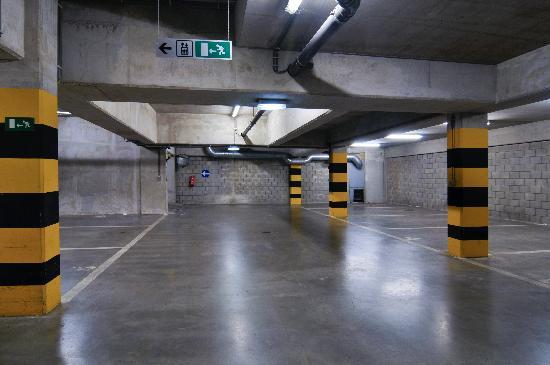Underground car park
A car park is a designated area or building where cars and other vehicles can be parked and left temporarily. In American English, it is referred to as a ‘parking lot’. Car parks are a common feature of the built environment, and often adjoin shopping centres, public buildings, schools, sports or entertainment venues, and so on.
For more information, see Car park.
Underground car parks are parking facilities that are built beneath the ground, either in the basement of a building or beneath a street. The primary advantage to this type of car park is that it can be developed in high-density urban areas where street-level space is at a premium. It is also hidden from view, and can provide enhanced security and weather protection for vehicles. However, access to and from underground car parks can be complex, as can building services such as lighting and ventilation, and they are typically expensive to excavate and construct. Security and safety measures must also be in place to prevent unauthorised access, provide surveillance and to facilitate escape in the event of an emergency.
Underground car parks can be constructed using steel sheet piles as a retaining structure, and concrete floors can be designed to stabilise the finished structure.
[edit] Related articles on Designing Buildings
- Basement excavation.
- Car park.
- Integrated transport system.
- Multi-storey car park.
- Planning (Subterranean Development) Bill.
- Overview of the road development process.
- Road traffic management.
- Tired of the commute? It might be time to take cars underground.
- Traffic engineering.
- Transport design and health.
- Types of road and street.
- Underground.
- Underground space.
Featured articles and news
RTPI leader to become new CIOB Chief Executive Officer
Dr Victoria Hills MRTPI, FICE to take over after Caroline Gumble’s departure.
Social and affordable housing, a long term plan for delivery
The “Delivering a Decade of Renewal for Social and Affordable Housing” strategy sets out future path.
A change to adoptive architecture
Effects of global weather warming on architectural detailing, material choice and human interaction.
The proposed publicly owned and backed subsidiary of Homes England, to facilitate new homes.
How big is the problem and what can we do to mitigate the effects?
Overheating guidance and tools for building designers
A number of cool guides to help with the heat.
The UK's Modern Industrial Strategy: A 10 year plan
Previous consultation criticism, current key elements and general support with some persisting reservations.
Building Safety Regulator reforms
New roles, new staff and a new fast track service pave the way for a single construction regulator.
Architectural Technologist CPDs and Communications
CIAT CPD… and how you can do it!
Cooling centres and cool spaces
Managing extreme heat in cities by directing the public to places for heat stress relief and water sources.
Winter gardens: A brief history and warm variations
Extending the season with glass in different forms and terms.
Restoring Great Yarmouth's Winter Gardens
Transforming one of the least sustainable constructions imaginable.
Construction Skills Mission Board launch sector drive
Newly formed government and industry collaboration set strategy for recruiting an additional 100,000 construction workers a year.
New Architects Code comes into effect in September 2025
ARB Architects Code of Conduct and Practice available with ongoing consultation regarding guidance.
Welsh Skills Body (Medr) launches ambitious plan
The new skills body brings together funding and regulation of tertiary education and research for the devolved nation.
Paul Gandy FCIOB announced as next CIOB President
Former Tilbury Douglas CEO takes helm.
UK Infrastructure: A 10 Year Strategy. In brief with reactions
With the National Infrastructure and Service Transformation Authority (NISTA).
























Comments
where is says "authorised access" i believe it should be "Unauthorised"
Fixed thanks